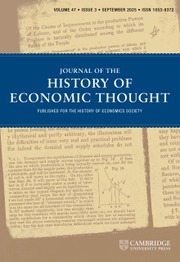Article contents
The Fall and Rise of Irving Fisher's Macroeconomics
Published online by Cambridge University Press: 11 June 2009
Extract
The history of economics provides many examples of economists, such as A. A. Cournot, and J. H. Von Thunen, whose work became influential only long after it was written. Others, like Francis A. Walker, loomed large during their careers, only to fade in the discipline's memory. Irving Fisher's reputation has followed a much less common trajectory. Once the most cited monetary economist, the subject of major review articles and the center of controversies over theory and policy, Fisher lost the profession's attention, vanished from citation lists in macroeconomics, and was regarded as an embarrassment by colleagues in his university and his discipline. Then, after his death, his contributions to macroeconomics became increasingly cited and influential, as macroeconomics developed in ways that brought it closer to Fisher's approach. New approaches have been found prefigured in Fisher's work, as when a 1926 article of his was reprinted in the Journal of Political Economy in 1973 as “I Discovered the Phillips Curve” (Fisher, 1997, 8). Fisher was once caricatured in introductory textbooks as the supposed exponent of a constant-velocity version of the quantity theory of money, the exemplar of simplistic pre- Keynesian economics swept away in the Keynesian Revolution, but recently there has been attention to Fisher as, in Keynes's phrase, “the great grandparent” of The General Theory, “who first influenced me strongly towards regarding money as a ‘real’ factor” (Keynes, 1971-89, 14, pp. 203 n.; Dimand, 1995; Kregel, 1988).
Information
- Type
- Articles
- Information
- Copyright
- Copyright © Cambridge University Press 1998
References
REFERENCES
- 10
- Cited by

